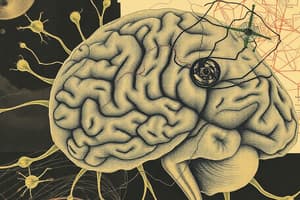Podcast
Questions and Answers
What is the primary function of the glymphatic system in the brain?
What is the primary function of the glymphatic system in the brain?
- To produce and maintain the myelin sheath around axons
- To serve as a functional waste clearance pathway in the brain (correct)
- To provide immune defense against infection and injury in the CNS
- To facilitate the exchange of oxygen and nutrients between the blood and the brain
Which type of glial cell is responsible for forming the insulative myelin sheath around axons in the CNS?
Which type of glial cell is responsible for forming the insulative myelin sheath around axons in the CNS?
- Oligodendrocytes (correct)
- Ependymal cells
- Microglia
- Astrocytes
What is the primary function of microglia in the CNS?
What is the primary function of microglia in the CNS?
- To produce and maintain the myelin sheath around axons
- To serve as the immune defense cells of the CNS (correct)
- To provide structural support to neurons
- To facilitate the exchange of nutrients and waste between the blood and the brain
What is the role of resting microglia in the CNS?
What is the role of resting microglia in the CNS?
During embryonic development, microglia migrate to the CNS from which tissue?
During embryonic development, microglia migrate to the CNS from which tissue?
What is the process by which microglia remove foreign invaders and tissue debris from the CNS?
What is the process by which microglia remove foreign invaders and tissue debris from the CNS?
What is the role of astrocytes in the brain?
What is the role of astrocytes in the brain?
What is the term for the process by which astrocytes facilitate the exchange of waste and toxins from the brain?
What is the term for the process by which astrocytes facilitate the exchange of waste and toxins from the brain?
What is the role of microglia in synaptic pruning during development and memory processing?
What is the role of microglia in synaptic pruning during development and memory processing?
What is the state of microglia when they are not activated by an infection or injury?
What is the state of microglia when they are not activated by an infection or injury?
Flashcards are hidden until you start studying
Study Notes
Glial Cells
- Glial cells communicate with neurons and among themselves through chemical signals.
- They support neurons physically and metabolically.
- They maintain the optimal composition of the extracellular environment surrounding neurons.
- They actively modulate synaptic function and are crucial for learning and memory.
Types of Glial Cells
- There are four major types of glial cells in the CNS: astrocytes, oligodendrocytes, microglia, and ependymal cells.
- Each type has specific roles.
Astrocytes
- Astrocytes are the most abundant glial cells and have a star-like shape.
- They hold neurons together in proper spatial relationships.
- They serve as a scaffold for neurons during fetal brain development.
- They induce the formation of the blood-brain barrier.
- They help transfer nutrients from the blood to neurons.
- They form neural scars to repair brain injuries.
- They take up and degrade excess neurotransmitters.
- They maintain optimal ion conditions around neurons.
Microglia
- Microglia are the immune defense cells of the CNS.
- They are similar to monocytes and derived from bone-marrow tissue.
- They migrate to the CNS during embryonic development and remain stationary until activated.
- In the resting state, they release low levels of growth factors to support neurons and glial cells.
- They play a role in synaptic pruning during development and memory processing.
- When activated, they move towards the affected area to remove foreign invaders or tissue debris by phagocytosis.
Ependymal Cells
- Ependymal cells line the internal, fluid-filled cavities of the CNS.
- They help form cerebrospinal fluid.
- They have cilia that contribute to the flow of cerebrospinal fluid.
- They serve as neural stem cells, able to form new neurons and glial cells, especially after injury.
Protection and Nourishment of the Brain
- The brain is protected by the absence of a lymphatic system, which is replaced by the glymphatic system.
- The glymphatic system facilitates a cleansing fluid exchange within brain spaces.
- Astrocytes facilitate this process, which increases during sleep.
- The brain is also protected by the myelin sheaths formed by oligodendrocytes around axons.
Studying That Suits You
Use AI to generate personalized quizzes and flashcards to suit your learning preferences.




